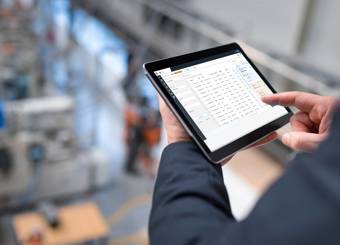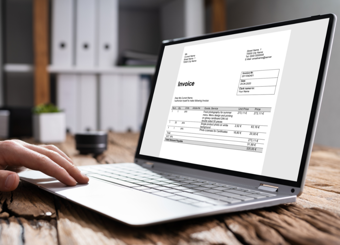Robotic Process Automation (RPA) in Accounts Payable
Buzzword or Useful Tool?
Chances are you’ve heard of the term “RPA,” short for Robotic Process Automation. It’s not a new terminology in business and finance, but it has become a “buzzword” of late and has the C-suite investigating whether it’s the right solution for their organization. For some companies, RPA can be a useful tool to satisfy their organizational needs. For many others, RPA can only scratch the surface of automating complex challenges, such as those within the accounts payable function.
What is Robotic Process Automation?
Robotic Process Automation, or RPA, is a technology that enables businesses to automate routine and repetitive tasks with software robots. These bots mimic human actions to complete processes faster and with higher accuracy, freeing up human employees for more complex and strategic work.
The genesis of RPA in accounts payable started from solving the problem for organizations that found themselves copying and pasting data between multiple business systems, such as accounting files and their ERPs. This manual and tedious task was a huge time suck for staff that could be solved by creating a script that could perform the task without the need for human intervention. These were straightforward robotics, written individually to perform a single task without much flexibility.
In the last 20 years, RPA has advanced beyond these initial, simple robotics. Some solution providers have unlocked more flexibility by weaving Artificial Intelligence (AI) into the code of the RPA, so that the robotics can learn from historical data and patterns to establish rules for how to handle dynamic scenarios. While this advancement has helped RPA to create more value for organizations, it still cannot unlock the more challenging, business-critical requirements for enterprise companies looking for true, touchless accounts payable automation.
Advancements in Accounts Payable Automation
Along the path of RPA’s evolution, automation solutions with more robust capabilities were also unlocking potential value for end-users with new technology, including similar AI functionalities that brought RPA additional value. But these technologies were built to perform more complex tasks, and bring other areas of the AP and procure-to-pay process under the umbrella of automation.
In early 2000, Optical Character Recognition (OCR) unlocked a further wealth of data that could enter into the automation process, and with that data came a boom in the automation market. Critical data from financial documents were now digitally captured and processed by these newly developed systems, eliminating the need for manual keying and copying and pasting.
That data could then be compared against filters and templates set up to match against pre-existing data in the ERP. It could also be assessed based on business logic rules that enabled important documents, like invoices, to be automatically processed for payment or flagged and routed directly to the appropriate reviewer for a next step.
Human Element in Automation
When it comes to modernizing accounts payable (AP) through automation, the critical influence of human engagement stands out. Beyond the conventional goals of enhancing efficiency and slashing costs, the adoption of Robotic Process Automation (RPA) profoundly impacts team dynamics and the essence of organizational culture.

Elevating AP Roles
Integrating automation into AP processes can revolutionize the AP team's role within a company. Automation liberates staff from the drudgery of manual tasks, propelling them towards more strategic functions. This elevation transforms AP from a purely operational unit to a pivotal strategic partner, simultaneously boosting job satisfaction and promoting professional growth.
With automation shouldering the routine load, employees can channel their efforts into critical areas like managing vendor relationships, analyzing cash flow, and projecting financial trends—domains where the human touch is invaluable.

Boosting Employee Engagement
Automation's role in AP extends its benefits to enhancing workplace satisfaction and engagement. By eliminating the monotony of repetitive tasks, automation paves the way for more engaging and diverse responsibilities. This shift not only decreases burnout risks but also cultivates a vibrant, dynamic workplace. Many organizations find that the chance to tackle high-value tasks encourages a culture of innovation, bolsters job satisfaction, and strengthens employee retention.
Automation, with a deliberate emphasis on nurturing the human aspect, promises to reshape the AP sector's future. It signals a new era of strategic and proactive professionals ready to address nuanced challenges.
Modern accounts payable automation picks up where RPA leaves off
These robust systems have a key feature where RPA is limited, and that feature is flexibility. Modern automation has evolved to deliver intuitive user features, such as point-and-click configurability that a business user can set up and modify to adapt to varying business needs, without needing to bring in IT resources. This configurability is delivered from the moment of deployment, whereas RPA requires additional functionality to be written within the code of the robotics, often starting from scratch for more complex functions.
Cloud-based accounts payable automation solutions offer even more flexibility for businesses. Upgrades and fixes are pushed to the solution on regular instances, without any need for the organization to spend time or resources to begin using new features.
RPA, on the other hand, must be manually upgraded or fixed, with IT or solution providers needing to access and rewrite code first. When you think on the scale of a multifaceted accounts payable process with dozens of different functions relying on automation, it’s clear how difficult, costly, and time-consuming that would be.
Robotic Process Automation relies heavily on the data provided by the organization, whether that’s through manual keying or a separate data capture tool. This adds further room for error, as manual data entry is known to be problematic.
Connecting outside systems with RPA requires layering coding to ensure that the data is processed according to business logic. Also, advanced data capture, such as line-level data, is nearly impossible to automate with RPA simply due to the number of variables involved with different invoice formats and business rules. True AP automation not only provides data capture in one, holistic solution, but can intelligently process incredible levels of detail from documents, and apply them to the out of the box best practice workflows to deliver a high degree of automation.
Cognitive Automation and AI Integration
The advent of Robotic Process Automation (RPA) in accounts payable marked a significant milestone in the journey towards operational efficiency. However, as the landscape of automation evolves, the integration of cognitive automation and artificial intelligence (AI) stands out as the next frontier in the quest for not just efficiency, but also intelligence and adaptability in financial operations.
Beyond Basic Automation
Cognitive automation, powered by AI, elevates the capabilities of traditional RPA systems by introducing elements of machine learning, natural language processing, and image recognition. This blend of technologies enables automation systems to handle not just repetitive tasks but also to make decisions, learn from outcomes, and adapt to changes over time. In the context of accounts payable, this means moving beyond data entry and invoice processing to more complex tasks such as interpreting invoice content, validating data against contracts and purchase orders, and even identifying and addressing exceptions without human intervention.
The integration of AI into accounts payable automation tools transforms them from task executors to problem solvers. These advanced systems can analyze historical data, recognize patterns, and predict outcomes, thereby facilitating more strategic decision-making processes. As an example, AI-enhanced tools can optimize payment timings to take advantage of early payment discounts or better manage cash flow by predicting future expenditure based on historical data.
The current AP automation market
The decision between RPA and accounts payable automation is further complicated by an accounts payable solution market that can be a confusing world to navigate. AP automation is often used as a label for several different solutions, including RPA. In many ways, these solutions do encompass automating various aspects of the accounts payable process. But their individual potential value can be very different, so organizations need to assess what their priority needs are and make sure they address those first with the solution they choose. Some solutions that commonly fall under the accounts payable label are:
- eInvoicing
- Invoice scanning software
- Invoice workflow automation
- Supplier portal
- Payment platforms
When it comes to choosing a solution that’s right for your organization, it’s essential that you stick to the scope of the challenges you’re looking to solve. For example, if eliminating manual steps and raising your level of touchless invoice processing in as little time as possible is the end-goal of your project, a supplier portal is likely the right fit for your organization.
Or if you process a relatively small volume of invoices but need a streamlined way to pay suppliers and combat fraud, you’re better off choosing an ePayment platform than an eInvoicing tool. Once you’ve landed on the scope of your process, you can follow the steps of identifying your system dependencies, assessing your current IT resources then researching and vetting vendors against these requirements to land on the best automation solution for your unique business needs.
Transforming Accounts Payable with AI and Machine Learning
The integration of Artificial Intelligence (AI) and Machine Learning (ML) into accounts payable automation marks a new era of efficiency and intelligence in financial operations. By detailing how these technologies are woven into the fabric of AP automation, we can appreciate the depth of transformation they bring to traditional processes.
Leveraging Advanced Technologies
AI and ML elevate accounts payable systems from automation tools to intelligent assistants capable of learning, reasoning, and making decisions. This integration allows for the automation of complex decision-making processes that were previously thought to require human intervention. For instance, ML algorithms can analyze patterns in invoice processing and payment timings to identify optimal strategies for cash flow management. Similarly, AI can be used to enhance fraud detection by learning to recognize signs of fraudulent activity that might elude human analysts.
The true power of AI and ML integration lies in their ability to learn from data. In the realm of accounts payable, this means that every invoice processed, every decision made, and every exception handled contributes to the system's growing knowledge base. Over time, this results in a system that not only becomes more efficient at its tasks but also more adept at identifying and addressing anomalies, leading to continuous improvement in process accuracy and reliability.
Comparative Analysis: RPA vs. Comprehensive AP Automation
The evolution of accounts payable (AP) processes from manual to automated solutions has significantly changed how businesses manage their finances. Robotic Process Automation (RPA) and comprehensive AP automation represent two pivotal technologies in this transition. Understanding their differences is crucial for businesses aiming to optimize their AP operations effectively.
RPA: The Starting Point
RPA has been instrumental in introducing automation to accounts payable, automating repetitive tasks such as data entry and invoice processing. Its rule-based system offers a level of efficiency that surpasses manual processes, reducing errors and speeding up operations.
However, RPA's capabilities are inherently limited by its reliance on predefined rules and lack of adaptability. It excels in structured environments but struggles with the complexities and nuances of comprehensive AP processes.
Comprehensive AP Automation: The Next Evolution
In contrast, comprehensive AP automation solutions represent a more holistic approach to automating the AP function. These solutions are not limited to automating repetitive tasks; they also bring intelligence, flexibility, and scalability to the entire AP process. With the integration of AI and machine learning, comprehensive AP automation solutions can adapt to changing conditions, learn from historical data, and make informed decisions. This allows for more than just automation; it enables optimization of the AP process.
Flexibility and Scalability
One of the most significant differences between RPA and comprehensive AP automation is in their flexibility and scalability. RPA, while effective for specific tasks, requires significant reconfiguration to adapt to changes in the AP process or business scale. Comprehensive AP automation solutions, on the other hand, are designed to easily scale with the business and adapt to new challenges, making them a more future-proof investment.
Integration Capabilities
Integration with existing financial systems and ERPs is another area where comprehensive AP automation solutions excel. Unlike RPA, which may require custom development to integrate with certain systems, comprehensive AP automation solutions often come with built-in compatibility or easily configurable options to ensure seamless data flow across all business systems. This integration capability enhances visibility, improves accuracy, and further streamlines the AP process.
Strategic Value
Perhaps the most compelling argument for comprehensive AP automation over RPA is the strategic value it brings to the organization. Beyond automating tasks, comprehensive solutions provide insights and analytics that can inform strategic decisions, improve vendor relationships, and optimize cash flow management. This transition from operational efficiency to strategic contribution marks a significant evolution in the role of the AP department within an organization.
Beyond RPA: Elevating Your Accounts Payable with Medius
While RPA has played a pivotal role in introducing automation to accounts payable, the limitations of its rule-based approach highlight the need for more sophisticated solutions. Comprehensive AP automation, with its emphasis on flexibility, scalability, and strategic value, offers a more effective path for businesses seeking to optimize their AP processes fully. As we look towards the future of financial operations, the choice between RPA for accounts payable and comprehensive AP automation will significantly influence an organization's ability to adapt, grow, and compete.
Ready to take the next step towards optimizing your accounts payable process with a solution that offers unparalleled flexibility, scalability, and strategic insight? Learn more about Medius's comprehensive AP automation solution or contact us today to schedule a personalized demo. Embrace the future of accounts payable with Medius!






